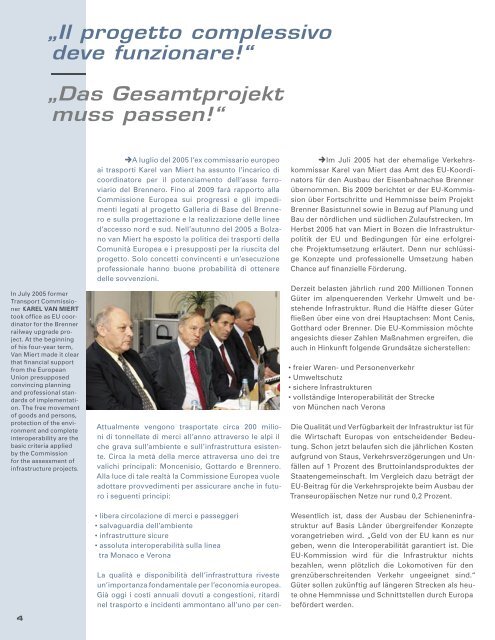Comunitā d'Azione Ferrovia del Brennero ... - BBT
Comunitā d'Azione Ferrovia del Brennero ... - BBT
Comunitā d'Azione Ferrovia del Brennero ... - BBT
Create successful ePaper yourself
Turn your PDF publications into a flip-book with our unique Google optimized e-Paper software.
In July 2005 former<br />
Transport Commissioner<br />
KAREL VAN MIERT<br />
took offi ce as EU coordinator<br />
for the Brenner<br />
railway upgrade project.<br />
At the beginning<br />
of his four-year term,<br />
Van Miert made it clear<br />
that fi nancial support<br />
from the European<br />
Union presupposed<br />
convincing planning<br />
and professional standards<br />
of implementation.<br />
The free movement<br />
of goods and persons,<br />
protection of the environment<br />
and complete<br />
interoperability are the<br />
basic criteria applied<br />
by the Commission<br />
for the assessment of<br />
infrastructure projects.<br />
4<br />
„Il progetto complessivo<br />
deve funzionare!“<br />
„Das Gesamtprojekt<br />
muss passen!“<br />
,A luglio <strong>del</strong> 2005 l’ex commissario europeo<br />
ai trasporti Karel van Miert ha assunto l’incarico di<br />
coordinatore per il potenziamento <strong>del</strong>l’asse ferroviario<br />
<strong>del</strong> <strong>Brennero</strong>. Fino al 2009 farà rapporto alla<br />
Commissione Europea sui progressi e gli impedimenti<br />
legati al progetto Galleria di Base <strong>del</strong> <strong>Brennero</strong><br />
e sulla progettazione e la realizzazione <strong>del</strong>le linee<br />
d’accesso nord e sud. Nell’autunno <strong>del</strong> 2005 a Bolzano<br />
van Miert ha esposto la politica dei trasporti <strong>del</strong>la<br />
Comunità Europea e i presupposti per la riuscita <strong>del</strong><br />
progetto. Solo concetti convincenti e un’esecuzione<br />
professionale hanno buone probabilità di ottenere<br />
<strong>del</strong>le sovvenzioni.<br />
Attualmente vengono trasportate circa 200 milioni<br />
di tonnellate di merci all’anno attraverso le alpi il<br />
che grava sull’ambiente e sull’infrastruttura esistente.<br />
Circa la metà <strong>del</strong>la merce attraversa uno dei tre<br />
valichi principali: Moncenisio, Gottardo e <strong>Brennero</strong>.<br />
Alla luce di tale realtà la Commissione Europea vuole<br />
adottare provvedimenti per assicurare anche in futuro<br />
i seguenti principi:<br />
• libera circolazione di merci e passeggeri<br />
• salvaguardia <strong>del</strong>l’ambiente<br />
• infrastrutture sicure<br />
• assoluta interoperabilità sulla linea<br />
tra Monaco e Verona<br />
La qualità e disponibilità <strong>del</strong>l’infrastruttura riveste<br />
un’importanza fondamentale per l’economia europea.<br />
Già oggi i costi annuali dovuti a congestioni, ritardi<br />
nel trasporto e incidenti ammontano all’uno per cen-<br />
,Im Juli 2005 hat der ehemalige Verkehrskommissar<br />
Karel van Miert das Amt des EU-Koordinators<br />
für den Ausbau der Eisenbahnachse Brenner<br />
übernommen. Bis 2009 berichtet er der EU-Kommission<br />
über Fortschritte und Hemmnisse beim Projekt<br />
Brenner Basistunnel sowie in Bezug auf Planung und<br />
Bau der nördlichen und südlichen Zulaufstrecken. Im<br />
Herbst 2005 hat van Miert in Bozen die Infrastrukturpolitik<br />
der EU und Bedingungen für eine erfolgreiche<br />
Projektumsetzung erläutert. Denn nur schlüssige<br />
Konzepte und professionelle Umsetzung haben<br />
Chance auf fi nanzielle Förderung.<br />
Derzeit belasten jährlich rund 200 Millionen Tonnen<br />
Güter im alpenquerenden Verkehr Umwelt und bestehende<br />
Infrastruktur. Rund die Hälfte dieser Güter<br />
fl ießen über eine von drei Hauptachsen: Mont Cenis,<br />
Gotthard oder Brenner. Die EU-Kommission möchte<br />
angesichts dieser Zahlen Maßnahmen ergreifen, die<br />
auch in Hinkunft folgende Grundsätze sicherstellen:<br />
• freier Waren- und Personenverkehr<br />
• Umweltschutz<br />
• sichere Infrastrukturen<br />
• vollständige Interoperabilität der Strecke<br />
von München nach Verona<br />
Die Qualität und Verfügbarkeit der Infrastruktur ist für<br />
die Wirtschaft Europas von entscheidender Bedeutung.<br />
Schon jetzt belaufen sich die jährlichen Kosten<br />
aufgrund von Staus, Verkehrsverzögerungen und Unfällen<br />
auf 1 Prozent des Bruttoinlandsproduktes der<br />
Staatengemeinschaft. Im Vergleich dazu beträgt der<br />
EU-Beitrag für die Verkehrsprojekte beim Ausbau der<br />
Transeuropäischen Netze nur rund 0,2 Prozent.<br />
Wesentlich ist, dass der Ausbau der Schieneninfrastruktur<br />
auf Basis Länder übergreifender Konzepte<br />
vorangetrieben wird. „Geld von der EU kann es nur<br />
geben, wenn die Interoperabilität garantiert ist. Die<br />
EU-Kommission wird für die Infrastruktur nichts<br />
bezahlen, wenn plötzlich die Lokomotiven für den<br />
grenzüberschreitenden Verkehr ungeeignet sind.“<br />
Güter sollen zukünftig auf längeren Strecken als heute<br />
ohne Hemmnisse und Schnittstellen durch Europa<br />
befördert werden.


